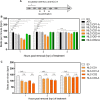Articaine in functional NLC show improved anesthesia and anti-inflammatory activity in zebrafish
- PMID: 33184457
- PMCID: PMC7665027
- DOI: 10.1038/s41598-020-76751-6
Articaine in functional NLC show improved anesthesia and anti-inflammatory activity in zebrafish
Abstract
Anesthetic failure is common in dental inflammation processes, even when modern agents, such as articaine, are used. Nanostructured lipid carriers (NLC) are systems with the potential to improve anesthetic efficacy, in which active excipients can provide desirable properties, such as anti-inflammatory. Coupling factorial design (FD) for in vitro formulation development with in vivo zebrafish tests, six different NLC formulations, composed of synthetic (cetyl palmitate/triglycerides) or natural (avocado butter/olive oil/copaiba oil) lipids were evaluated for loading articaine. The formulations selected by FD were physicochemically characterized, tested for shelf stability and in vitro release kinetics and had their in vivo effect (anti-inflammatory and anesthetic effect) screened in zebrafish. The optimized NLC formulation composed of avocado butter, copaiba oil, Tween 80 and 2% articaine showed adequate physicochemical properties (size = 217.7 ± 0.8 nm, PDI = 0.174 ± 0.004, zeta potential = - 40.2 ± 1.1 mV, %EE = 70.6 ± 1.8) and exhibited anti-inflammatory activity. The anesthetic effect on touch reaction and heart rate of zebrafish was improved to 100 and 60%, respectively, in comparison to free articaine. The combined FD/zebrafish approach was very effective to reveal the best articaine-in-NLC formulation, aiming the control of pain at inflamed tissues.
Conflict of interest statement
The authors declare no competing interests.
Figures





Similar articles
-
Improved Local Anesthesia at Inflamed Tissue Using the Association of Articaine and Copaiba Oil in Avocado Butter Nanostructured Lipid Carriers.Pharmaceuticals (Basel). 2023 Apr 5;16(4):546. doi: 10.3390/ph16040546. Pharmaceuticals (Basel). 2023. PMID: 37111303 Free PMC article.
-
Natural lipids-based NLC containing lidocaine: from pre-formulation to in vivo studies.Eur J Pharm Sci. 2017 Aug 30;106:102-112. doi: 10.1016/j.ejps.2017.05.060. Epub 2017 May 27. Eur J Pharm Sci. 2017. PMID: 28558981
-
Bupivacaine (S75:R25) Loaded in Nanostructured Lipid Carriers: Factorial Design, HPLC Quantification Method and Physicochemical Stability Study.Curr Drug Deliv. 2018;15(3):388-396. doi: 10.2174/1567201814666170726101113. Curr Drug Deliv. 2018. PMID: 28745230
-
Articaine: an effective adjunctive local anesthetic for painless surgery at the depth of the muscular fascia.Dermatol Surg. 2006 Mar;32(3):407-10. doi: 10.1111/j.1524-4725.2006.032082.x. Dermatol Surg. 2006. PMID: 16640688 Review.
-
Efficacy of articaine formulations: quantitative reviews.Dent Clin North Am. 2010 Oct;54(4):643-53. doi: 10.1016/j.cden.2010.06.005. Dent Clin North Am. 2010. PMID: 20831928 Review.
Cited by
-
Fresh Carrier for an Old Topical Local Anesthetic: Benzocaine in Nanostructured Lipid Carriers.ACS Biomater Sci Eng. 2024 Aug 12;10(8):4958-4969. doi: 10.1021/acsbiomaterials.4c00585. Epub 2024 Jul 29. ACS Biomater Sci Eng. 2024. PMID: 39074333 Free PMC article.
-
Codelivery of Paclitaxel and Cannabidiol in Lipid Nanoparticles Enhances Cytotoxicity against Melanoma Cells.ACS Omega. 2025 May 22;10(21):21568-21580. doi: 10.1021/acsomega.5c00689. eCollection 2025 Jun 3. ACS Omega. 2025. PMID: 40488002 Free PMC article.
-
Evaluation of the biological activities of Copaiba (Copaifera spp): a comprehensive review based on scientometric analysis.Front Pharmacol. 2023 Sep 1;14:1215437. doi: 10.3389/fphar.2023.1215437. eCollection 2023. Front Pharmacol. 2023. PMID: 37719866 Free PMC article.
-
Docetaxel Loaded in Copaiba Oil-Nanostructured Lipid Carriers as a Promising DDS for Breast Cancer Treatment.Molecules. 2022 Dec 13;27(24):8838. doi: 10.3390/molecules27248838. Molecules. 2022. PMID: 36557969 Free PMC article.
-
Isolation and characterization of plant-derived exosome-like nanoparticles from Carica papaya L. fruit and their potential as anti-inflammatory agent.PLoS One. 2024 Jul 3;19(7):e0304335. doi: 10.1371/journal.pone.0304335. eCollection 2024. PLoS One. 2024. PMID: 38959219 Free PMC article.
References
-
- Berde CB, Strichartz GR. Local anesthetics. In: Miller RD, editor. Miller’s Anesthesia. Oxford: Elsevier; 2016. pp. 1028–1054.
-
- Seward GR. Handbook of local anesthesia. J. Dent. 1981;9:32.
-
- Peters MC, Botero TM. In Patients with symptomatic irreversible Pulpitis, Articaine is 3.6 times more efficacious than lidocaine in achieving anesthetic success when used for supplementary infiltration after mandibular block anesthesia. J. Evid. Based. Dent. Pract. 2017;17:99–101. doi: 10.1016/j.jebdp.2017.03.003. - DOI - PubMed
Publication types
MeSH terms
Substances
LinkOut - more resources
Full Text Sources
Medical
Molecular Biology Databases

